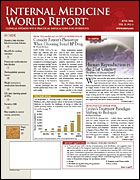Publication
Article
Internal Medicine World Report
Avert Late-Life Depression after a Disabling Event
Author(s):
From the American Association for Geriatric Psychiatry
SAN JUAN, Puerto Rico—Late-life depression severely diminishes quality of life, complicates the course of medical illnesses and their management, decreases the likelihood of functional recovery, and increases the risk of death. Because disability is one of the strongest predictors of depression in the elderly, preventing depression in this context should be a public health priority, suggests Eric Lenze, MD, of the Western Psychiatric Institute and Clinic and the Department of Psychiatry at the University of Pittsburgh in Pennsylvania.
Speaking at the Annual Meeting of the American Association for Geriatric Psychiatry, Dr Lenze noted that major depressive disorder (MDD) occurs in an estimated 9% to 28% of patients after a disabling event such as a heart attack or hip fracture and in probably even a greater proportion of patients after a stroke. Each year, an estimated 0.5 million to 1.7 million people in the United States develop MDD after a disabling medical event. Less severe forms of depression are even more common.
Among a sample of just over 100 elderly hip fracture patients who did not have MDD previously, about 18% developed MDD, almost always within the first 6 months postfracture. Identifying this distinct risk period raises the possibility that short-term interventions could avert its occurrence. Dr Lenze emphasized that preventing depression is preferable to treating it. “Late-life depression in this context does a lot of bad things,” he said. “Studies have shown that people who develop depression after events such as stroke or hip fractures are far less likely to recover to anything like a premorbid level of function.”
Risk factors for depression after disability are female gender, personal or family history of depression, apathy, or subsyndromal depressive symptoms, that is, “people with a ‘speck’ of depression already,” Dr Lenze explained.
Genetics may play a role as well, especially polymorphisms in the human serotonin transporter gene (5-HTTLPR), particularly in the context of stressful life events, such as disability. Other genes may also be involved, such as tryptophan hydroxylase-2 (the rate-limiting enzyme in serotonin formation), brain-derived neurotrophic factor, and cytokine pathway genes.
Dr Lenze said nursing homes are more “depressogenic” than hospitals for rehabilitation. “That’s about to become a major issue in geriatrics, as Medicare rules are making more and more elderly patients go to nursing homes for rehab,” he warned.
Strategies to prevent the development of depression include problem-solving therapy and the use of selective serotonin reuptake inhibitors (SSRIs).
Novel prevention strategies that are not currently used to treat depression have been suggested by the neuroscience literature. For example, the “learned helplessness reaction” occurs in mice, monkeys, and humans who are exposed to severe or inescapable stress. In animals it manifests as amotivation, apathy, hostility, and helpless behaviors—all of which are similar to the manifestations of depression in people.
Dr Lenze said that SSRIs help prevent learned helplessness, as do “a class of medications that we don’t use by and large as antidepressants—glutamate antagonists, such as memantine” (Namenda).
Although one study did not find memantine beneficial as treatment for depression, it may still be useful in prevention. Dr Lenze and colleagues are investigating whether the drug can prevent or lessen the severity of depression in patients aged ≥60 years who are at high risk for MDD and who have been admitted to a nursing home for rehabilitation after a disabling medical event.





